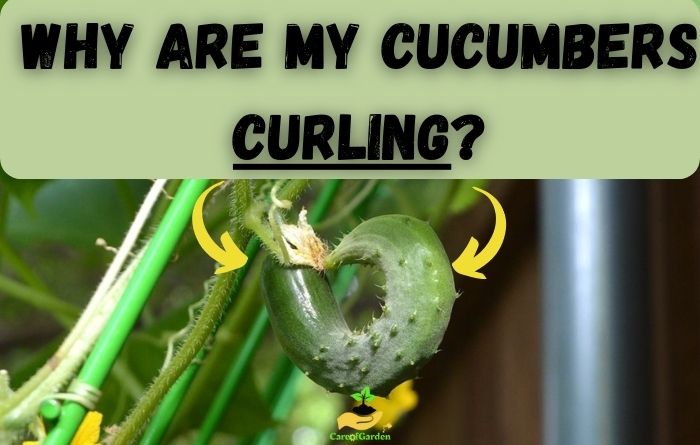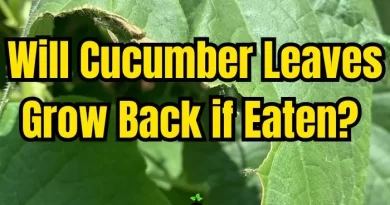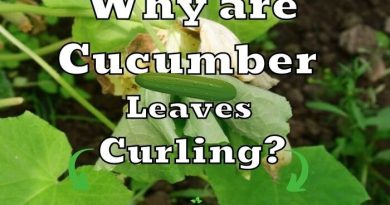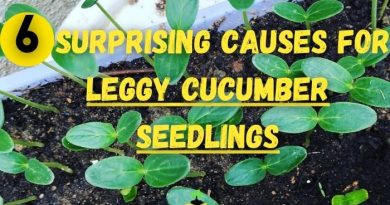Why are My Cucumbers Curling? Here’s How to Stop It!
Are your cucumbers curling and ruining your harvest? Don’t worry, we’ve got you covered. In this blog post, we’ll explain why cucumbers curl and provide practical tips to prevent it from happening. By the end of this post, you’ll be equipped with the knowledge to grow straight, healthy cucumbers and enjoy a bountiful harvest.
Cucumbers are curling due to a variety of factors, including lack of water, insufficient pollination, high temperatures, nutrient deficiencies, overcrowding, and genetics. To prevent cucumber curling, it’s important to provide consistent moisture, select proper varieties, provide adequate spacing, monitor soil moisture, and harvest at the right time. Additionally, water regularly, provide shade, use insecticides, and fertilize appropriately to promote healthy growth of the fruit. Protecting the plants from extreme temperatures, pests, and overcrowding can also help to prevent curling.
Why are Cucumbers Curling:
1. Lack of Water
Cucumbers require a lot of water to grow and thrive, and a lack of water can cause them to curl or become deformed. This happens because cucumbers have a response called hydrotropism meaning their roots seek out areas with more moisture to compensate for dehydration. As a result, the stem may bend and the fruit may curl.
To prevent cucumber curling due to lack of water it’s crucial to ensure that your plants receive an adequate amount of water. The soil should be moist but not overly saturated. You should aim to water your cucumber regularly.
Treatment
If you want to fix cucumber curl caused by a lack of water here are some of my recommended treatments:
- Water regularly: Make sure you give your cucumber plants water on a regular basis, especially during hot weather.
- Mulch: Apply a layer of mulch around the base of your plants. This will help the soil retain moisture and prevent evaporation. By keeping the roots cool and maintaining moisture levels you can minimize plant stress.
- Monitor soil moisture: Use a soil moisture meter. Simply stick your finger into the soil to check its moisture levels regularly. If the soil feels dry it’s an indication that its time to water your plants.
2. Sudden Changes in Temperature

Cucumbers may curl when subjected to temperature changes a phenomenon referred to as thermal shock. Cucumbers are quite sensitive to fluctuations in temperature and such abrupt changes can induce stress on the plants ultimately resulting in the curling of their fruit.
When temperatures experience shifts the cucumber ability to adapt quickly may be compromised, leading to cell damage within the fruit. This damage subsequently causes the fruit to take on misshapen or curled forms.
Reading some scientific papers I learn that sudden temperature changes prompt the plant to prioritize resource allocation towards repairing this damage rather than focusing on fruitful development. Consequently, this redirection of resources further contributes to the curling of the fruit.
Treatment
To prevent cucumber fruits from curling due to temperature fluctuations it is essential to create a stable environment for the plants. This involves avoiding exposure to hot or cold temperatures.
If you reside in an area with temperature changes you can shield your cucumber plants by using row covers, shade cloth or umbrellas. These protective measures will help maintain a temperature and prevent thermal shock.
Furthermore, cultivating your cucumber plants in a greenhouse or controlled environment will provide a stable temperature. This approach safeguards them against shifts in temperature and ensures a stable setting for healthy growth.
Should you encounter a change in temperature, closely monitor your cucumbers and offer necessary support like increased watering or fertilization to aid their recovery from any potential damage.
3. Insufficient pollination
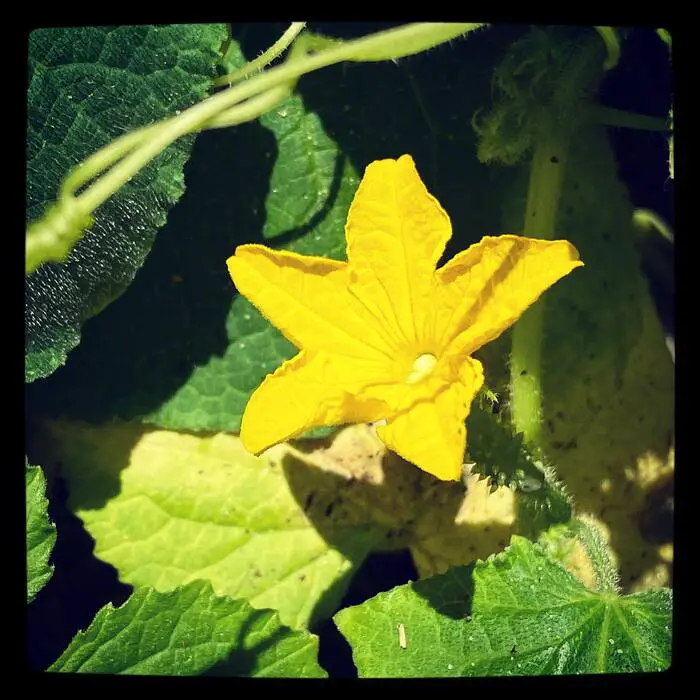
Insufficient pollination can result in the curving of cucumbers due to a lack of proper development. Cucumbers need pollination for proper growth and if they don’t receive enough the fruit may not develop uniformly. This lack of development can cause the cucumbers to take on irregular or curled shapes.
From my experience, when there is poor pollination the fruit tends to grow at a slower pace, which can lead to deformities as it continues its growth. When a cucumber flower isn’t adequately pollinated the fruit may not fully develop, resulting in misshapen sections. This can ultimately cause the cucumber to become curled or distorted.
Treatment
To prevent cucumber fruits from curling due to subpar pollination it’s crucial to ensure that your plants receive sufficient pollination. One effective method is by creating an inviting environment for pollinators like bees, butterflies and other insects.
You can achieve this by planting flowers that attract these insects while avoiding pesticides that could harm them. Additionally providing a water source for them will further encourage their presence.
Another approach I take is to, manually hand pollinate my cucumber plants using a brush or cotton swab can be beneficial if you have only a few plants or if there is a shortage of natural pollinators, in your vicinity.
To ensure pollination you can also consider planting cucumber varieties that are self-pollinating or have a high success rate, in pollination.
I have found out that these cucumber varieties are self-pollinating:
| Cucumber Variety | Type |
|---|---|
| Marketmore | Slicing |
| Straight Eight | Slicing |
| Lemon | Pickling |
| Armenian | Specialty |
| Diva | Specialty |
| Sweet Success | Specialty |
4. Lack of Nutrients
After consulting some sources and asking other fellow gardeners they suggest that a lack of nutrients, particularly potassium, can contribute to the curling of cucumber.
The lack of these nutrients can cause the cucumber fruit to become misshapen and curl, while their leaves may yellow and bend down.
| Nutrient Deficiency | Curling Behavior in Cucumber | Solution |
|---|---|---|
| Nitrogen | Becomes narrower towards the end, with a sharper tip where the flower was previously located. The fruit may also turn light green in color. | Feed with nitrogen fertilizers, such as urea or ammonium nitrate, or use organic fertilizers like herbal infusion or mullein solution |
| Potassium | Become club-shaped or pear-shaped, with a narrowing at the base where it attaches to the stalk and a thickening towards the top. | Feed with potassium salt or ash solution, or use organic fertilizers like mullein or bird droppings |
Treatment
Organic fertilizers, such as mullein or herbal infusions, can also be used to supply the necessary nutrients to the soil. However, it’s important not to overdo it, as an excess of nutrients can cause other issues for the plants.
To address potassium deficiency, plants can be treated with a solution of potassium salt or wood ash, while nitrogen deficiency can be remedied with urea or ammonium nitrate.
5. Overcrowding
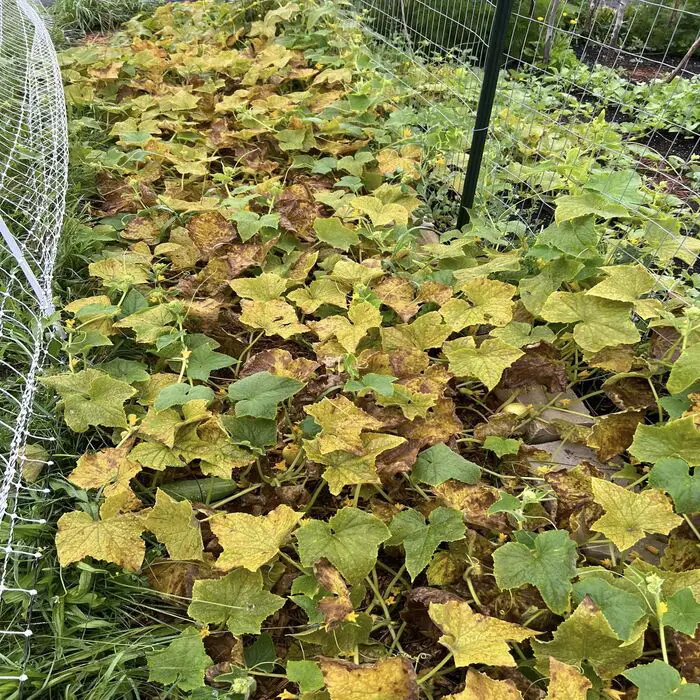
When cucumber plants are too close together they may not have room to grow properly leading to competition for essential resources like water and nutrients. This competition will stress your cucumbers, which can also hinder their development, causing to become twisted or misshapen.
As far as I know, overcrowding also limits air circulation around the plants, which increases humidity levels and raises the risk of diseases. These factors further contribute to fruit curling due, to added plant stress.
Treatment
To fix cucumber curls due to overcrowding, I suggest you do these steps:
- Transplanting: If your cucumber plants are too crowded consider moving some of them to a location. This will create room for each plant and minimize competition for resources.
- Pruning: Another option is to trim your cucumber plants by removing excess growth. This will enhance air circulation reduce humidity levels and prevent diseases that can stress the plants and lead to fruit curling.
- Providing support: If you are cultivating climbing cucumbers consider using trellises or stakes for support. This will help maintain growth prevent overcrowding improve airflow and reduce humidity levels.
- Thinning out: In cases of overcrowding thinning out cucumber plants can be effective. By removing some plants you allow resources, for the remaining ones and minimize resource competition.
6. High Temperature
High temperatures can cause the curling of cucumber fruits as it puts stress on them. Cucumbers are quite sensitive to temperatures and when “the mercury rises” too much it causes stress to the plant resulting in misshapen or curled fruits.
Basically, elevated temperatures can harm the cells within the fruit leading to deformities and curling.
As I found out, high temperatures compel the plant to allocate its resources towards regulating its temperature rather than focusing on fruit development, which further contributes to fruit curling.
When a plant is, under stress, it struggles to develop fruits ultimately causing them to become curled or deformed.
Treatment
To avoid cucumber fruit curl caused by high temperatures it’s crucial to create a cool and consistent environment for cucumber plants.
Here are some suggestions you should take:
- Provide shade: Utilize shade cloth or other materials to shield your plants from the sun during the part of the day. This will help maintain temperatures and prevent plant stress.
- Water regularly: Ensure that you water your cucumber plants adequately in hot weather conditions. This will keep the soil moist and cool preventing plant stress.
- Start mulching: Apply a layer of mulch around the base of your plants to retain moisture in the soil and minimize evaporation. This will help the roots alleviate plant stress.
- Provide good ventilation: Make certain that your cucumbers have air circulation to keep them cool. You can achieve this by spacing them and using fans or other means to create a gentle breeze.
7. Harvesting Too Late
If cucumbers are left on the vine for long they can become overripe and develop a thicker skin, which causes them to grow misshapen.
Moreover, overripe cucumbers may not receive nutrients from the cucumber plant leading to stress and resulting in curved fruit. This is particularly true, for vining cucumber varieties as they can continue growing after reaching maturity.
Treatment
To avoid ripening and curling of the fruit it is crucial to harvest cucumbers at the right time. By picking them when they’re mature but still firm growers can ensure proper development of the fruit without any curling or deformities.
8. Genetics
Cucumber fruit can sometimes curl due to the way certain types of cucumbers are bred. Some cucumber varieties are more prone to curling than others because of their genetic makeup.
This can be influenced by factors like the shape of the fruit the thickness of its skin and how it develops. For instance, certain cucumber varieties are intentionally bred to have a cylindrical shape making them more likely to curl.
Additionally, some varieties may have skin, which can result in misshapen growth. Lastly, some cucumber varieties may have an inherited tendency for curled fruit across generations.
Although genetics play a role in cucumber fruit curling it’s important to note that other factors, like stress or insufficient pollination, can also contribute to this condition.
Treatment
If the reason behind the curling of cucumber fruits is genetics there might not be a remedy or solution to prevent it. However, farmers have the option to choose cucumber varieties that are less susceptible to curling because of their genetic makeup.
This can be accomplished by conducting research and opting for varieties that are recognized for their shape and texture or by selecting specially bred varieties that are resistant, to curling.
Here are cucumber varieties that I found to be more prone to fruit curling due to their genetics:
| Cucumber Variety | Description |
|---|---|
| Lemon Cucumber | This variety is small and round, with a yellow-green skin and a mild flavor. It is known for its tendency to develop curled fruit. |
| Armenian Cucumber | This variety is long and thin, with a light green skin and a mild flavor. It is known for its tendency to develop curled fruit, especially if it is not harvested at the right time. |
| English Cucumber | This variety is long and thin, with a dark green skin and a mild flavor. It is known for its tendency to develop curled fruit if it is not harvested at the right time or if it is exposed to stress, such as high temperatures or inconsistent moisture. |
| Beit Alpha Cucumber | This variety is small and round, with a thin skin and a sweet flavor. It is known for its tendency to develop curled fruit, especially if it is not harvested at the right time or if it is exposed to stress. |
How to Prevent Cucumber from Curling
- Provide consistent moisture: Make sure to water your cucumber plants regularly, especially during hot weather. This will help to keep the soil moist and cool, which can prevent stress on the plant.
- Adequate spacing: Provide adequate space for each plant to grow properly. Overcrowding can cause cucumber fruit to curl due to competition for resources among the plants.
- Select proper varieties: Choose cucumber varieties that are less prone to fruit curling due to their genetics.
- Maintain proper nutrition: Cucumber plants require nutrient-rich soil. They fall in the category of “heavy feeders,” which means you most probably will have to fertilize them regularly.
- Monitor pests: Keep an eye out for insect damage, which can interfere with developing cucumber fruits, causing them to curl irregularly.
- Harvest at the right time: Harvest cucumbers when they are mature but still firm, to prevent over-ripening and curling of the fruit.
- Prune and support: Prune your cucumber plants to remove any excess growth and promote better air circulation. Provide support such as trellises or stakes to help keep the plants upright and reduce crowding.
Conclusion
In conclusion, cucumber curling can occur due to reasons such as environmental stress, genetics, overcrowding, inadequate watering, and other factors. It is crucial to verify the exact cause that led to your cucumber curling to successfully prevent its occurrence in the future.

